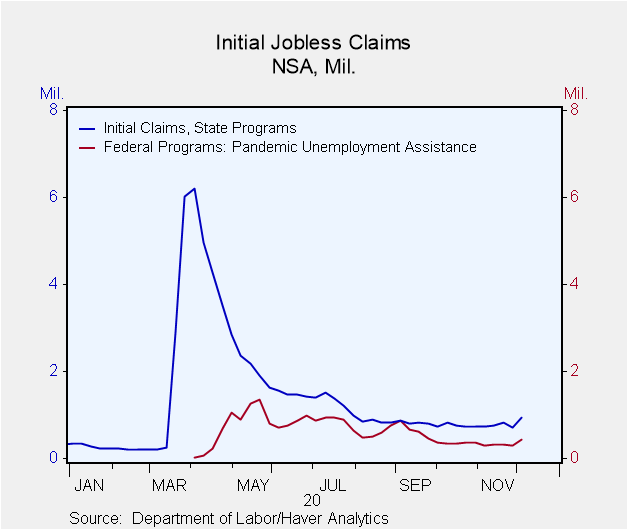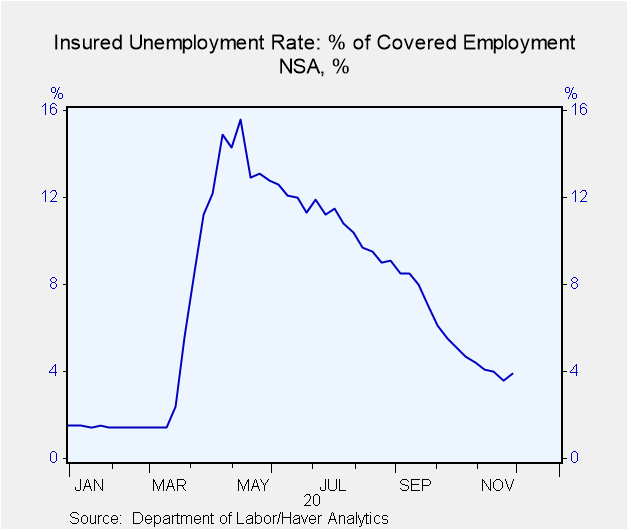 Global| Dec 10 2020
Global| Dec 10 2020COVID Resurgence Hits U.S. Labor Market as Initial Jobless Claims Jump
Summary
• State and Federal Pandemic Unemployment Assistance initial claims return to September levels. • Continuing claims increase for state, while PUA and PEUC decline. • Absent action, 13.1 million PUA and PEUC claimants will lose their [...]
• State and Federal Pandemic Unemployment Assistance initial claims return to September levels.
• Continuing claims increase for state, while PUA and PEUC decline.
• Absent action, 13.1 million PUA and PEUC claimants will lose their benefits in January.
• Department of Labor wording change reflects challenges in reporting continuing claims.
Seasonally adjusted state initial jobless claims for unemployment insurance jumped to 853,000 in the week ending December 5 from a slightly upwardly-revised 716,000 in the previous week (was 712,000). This is the highest level of claims since September 19. The Action Economics Forecast Survey anticipated 720,000. A change in the calculation of seasonal adjustment factors created a break in the series in late August. Though the current comparison to mid-September is valid, comparisons to before August 22 are not. For more details, please see the September 3 commentary on jobless claims.
Claims for the federal Pandemic Unemployment Assistance (PUA) program, which covers individuals such as the self-employed who are not qualified for regular/state unemployment insurance, surged to 427,609 from 288,234. This is the highest since September 26. Numbers for this and other federal programs are not seasonally adjusted.
Seasonally adjusted state continuing claims for unemployment insurance rose to 5.757 million in the week ending November 28, from 5.527 million. Continuing PUA claims, which are lagged an additional week and not seasonally adjusted, declined to 8.556 million from 8.870 million. Pandemic Emergency Unemployment Compensation (PEUC) claims edged down to 4.533 million in the week ending November 21. This program covers people who were unemployed before COVID but exhausted their state benefits and are now eligible to receive an additional 13 weeks of unemployment insurance, up to a total of 39 weeks. Funding for both PUA and PEUC programs is set to expire on December 26, which means that at current levels, 13.1 million people would lose their benefits in January.
In their latest report the Department of Labor changed the description of continuing claims from "Persons Claiming" to "Continued Weeks Claimed" noting "continued weeks claimed represent all weeks of benefits claimed during the week being reported, and do not represent the number of unique individuals filing continued claims." This is a result of challenges states have had reporting backlogs in claims. For more details on this issue, see Measuring employment during COVID 19: challenges and opportunities.
The seasonally adjusted state insured rate of unemployment ticked up to 3.9% in the week ending November 28 from 3.8%. This data does not include the federal pandemic assistance programs. If you include the latest data available, which is lagged one additional week, the total number of state, PUA and PEUC continuing claims rose to 18.9 million or 11.8% of the labor force.
The state insured rates of unemployment – which do not include federal programs – continued to show wide variation with South Dakota at just 0.7% and California at 6.3%. The largest states ranged between 1.6% for Florida and the 6.3% noted above for California. The state rates are not seasonally adjusted.
Data on weekly unemployment claims going back to 1967 are contained in Haver's WEEKLY database, and they are summarized monthly in USECON. Data for individual states are in REGIONW. The expectations figure is from the Action Economics Forecast Survey, carried in the AS1REPNA database.
| Unemployment Insurance (SA, 000s) | 12/05/20 | 11/28/20 | 11/21/20 | Y/Y % | 2019 | 2018 | 2017 |
|---|---|---|---|---|---|---|---|
| Initial Claims | 853 | 716 | 787 | 260 | 218 | 221 | 244 |
| Initial Claims (NSA) | 948 | 719 | 836 | 198 | 218 | 221 | 243 |
| Initial Claims Pandemic Unemployment Assistance (NSA) | 428 | 288 | 319 | -- | -- | -- | -- |
| Continuing Claims | -- | 5,757 | 5,527 | 239 | 1,701 | 1,756 | 1,961 |
| Continuing Claims (NSA) | -- | 5,781 | 5,248 | 229 | 1,704 | 1,763 | 1,964 |
| Continuing Claims Pandemic Unemployment Assistance (SA) | -- | -- | 8,556 | -- | -- | -- | -- |
| Insured Unemployment Rate (%) | -- | 3.9 | 3.8 |
1.2 |
1.2 | 1.2 | 1.4 |
Gerald D. Cohen
AuthorMore in Author Profile »Gerald Cohen provides strategic vision and leadership of the translational economic research and policy initiatives at the Kenan Institute of Private Enterprise.
He has worked in both the public and private sectors focusing on the intersection between financial markets and economic fundamentals. He was a Senior Economist at Haver Analytics from January 2019 to February 2021. During the Obama Administration Gerald was Deputy Assistant Secretary for Macroeconomic Analysis at the U.S. Department of Treasury where he helped formulate and evaluate the impact of policy proposals on the U.S. economy. Prior to Treasury, he co-managed a global macro fund at Ziff Brothers Investments.
Gerald holds a bachelor’s of science from the Massachusetts Institute of Technology and a Ph.D. in Economics from Harvard University and is a contributing author to 30-Second Money as well as a co-author of Political Cycles and the Macroeconomy.









